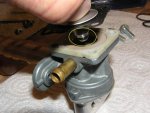stoodybaker
Bicycle
I did a search, and couldn't seem to find this issue. I was curious if anyone else had ever had this problem.
I had some medical problems last fall, which left my bike stranded at a friend's house all winter (and spring). Needless to say, the gas wasn't in the best condition. It did drive home, but had flat spots, etc. Pulled the carbs (and found one loose jet), and cleaned them. After a successful test drive of about 50 miles, I parked at home, and promptly noticed yee old gas puddle under the drain line (provided by Sunny Steve with the overflows).
Well, long story short, I found that vacuum would OPEN the petcock, but releasing that vacuum would not close it.....unless the cover was unscrewed, releasing the vacuum.
I never even KNEW there was a check valve built into the vacuum port of the petcock.
My assumption is there is supposed to be a controlled bleed back, letting the valve close, and that this bleed just got gunked up....
Anyone have any more information on this situation??
I had some medical problems last fall, which left my bike stranded at a friend's house all winter (and spring). Needless to say, the gas wasn't in the best condition. It did drive home, but had flat spots, etc. Pulled the carbs (and found one loose jet), and cleaned them. After a successful test drive of about 50 miles, I parked at home, and promptly noticed yee old gas puddle under the drain line (provided by Sunny Steve with the overflows).
Well, long story short, I found that vacuum would OPEN the petcock, but releasing that vacuum would not close it.....unless the cover was unscrewed, releasing the vacuum.
I never even KNEW there was a check valve built into the vacuum port of the petcock.
My assumption is there is supposed to be a controlled bleed back, letting the valve close, and that this bleed just got gunked up....
Anyone have any more information on this situation??



